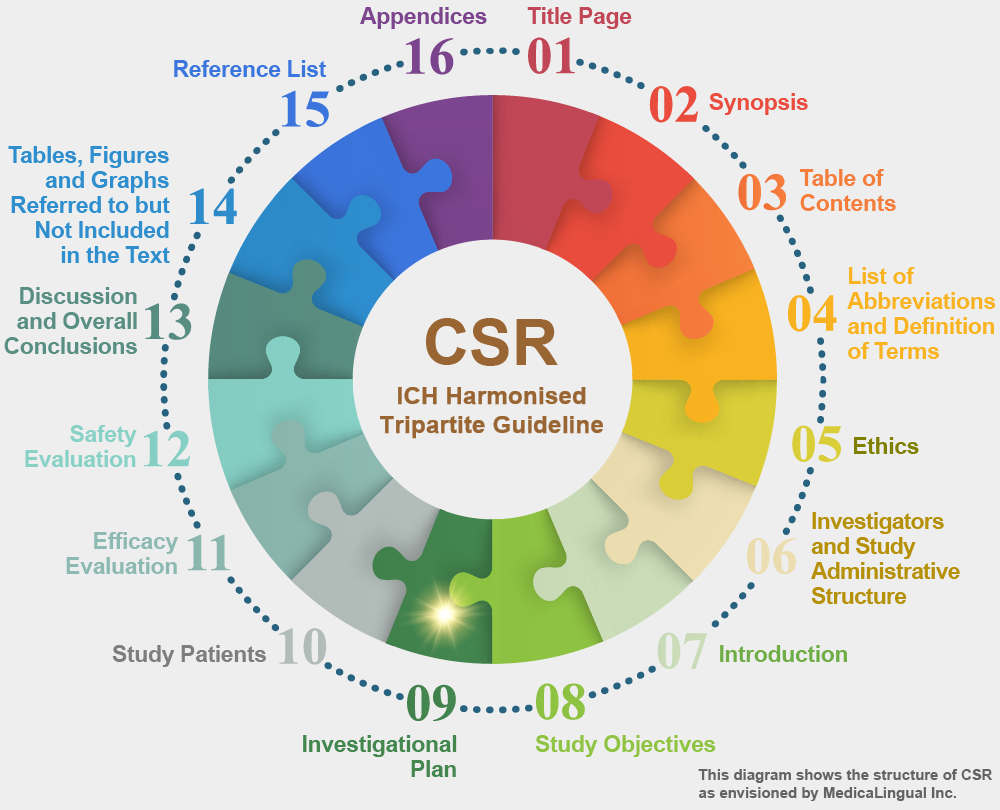
治験の統括報告書の構成と内容に関するガイドライン
平成8年5月1日 薬審第335号
各都道府県衛生主管部(局)長あて 厚生省薬務局審査課長通知
STRUCTURE AND CONTENT OF CLINICAL STUDY REPORTS
Recommended for Adoption at Step 4 of the ICH Process on 30 November 1995 by the ICH Steering Committee
9. 治験の計画
9.4 治療法
9.4.1 治療法
治験の各群において,さらに治験の各期間において用いられる治療又は診断薬について,投与経路,投与方法,用量及び投与スケジュールを詳細に記述すること。
9. INVESTIGATIONAL PLAN
9.4 TREATMENTS
9.4.1 TREATMENTS ADMINISTERED
The precise treatments or diagnostic agents to be administered in each arm of the study, and for each period of the study, should be described including route and mode of administration, dose and dosage schedule.
9.4.2 治験薬の同定
総括報告書の本文中に,治験薬(剤型,含量,ロット番号)の簡単な記述を行うこと。複数のロットの薬剤が用いられた場合には,付録16.1.6にそれぞれのロットが投与された患者を特定し,記述すること。
9.4.2 IDENTITY OF INVESTIGATIONAL PRODUCT(S)
In the text of the report, a brief description of the test drug(s)/investigational product(s) (formulation, strength, batch number(s)) should be given. If more than one batch of test drug/investigational product was used, patients receiving each batch should be identified in appendix 16.1.6.
プラセボ及び実対照薬の入手先を示すこと。実対照薬について,市販されている通常の状態から変更された場合には,全ての変更内容を示し,生物学的利用能が変わらないことを保証するためにとられた手順を記述すること。
The source of placebos and active control/comparator product(s) should be provided. Any modification of comparator product(s) from their usual commercial state should be noted, and the steps taken to assure that their bioavailability was unaltered should be described.
有効期間が限られていたり,又は安定性データが不完備である治験薬を用いた長期投与試験については,治験薬の再交付の手段について記述すること。有効期限の過ぎた治験薬が使用された場合には,どのような場合でもその旨を記載し,投与された患者を明確にすること。もし,保管上特に必要な事項があるなら,それらも記述すること。
For long-duration trials of investigational products with limited shelf-lives or incomplete stability data, the logistics of resupply of the materials should be described. Any use of test materials past their expiry date should be noted, and patients receiving them identified. If there were specific storage requirements, these should also be described.
9.4.3 治療群への患者の割付け方法
患者を治療群に割り付けるために用いた特定の方法,例えば,中央割付け,施設内割付け,適応的割付け(つまりそれ以前の割付け又は結果を基にした割付け)について,層別化又はブロック化の手順も含めて報告書の本文中に記述すること。一般的ではない特徴について全て説明すること。
9.4.3 METHOD OF ASSIGNING PATIENTS TO TREATMENT GROUPS
The specific methods used to assign patients to treatment groups, e.g., centralised allocation, allocation within sites, adaptive allocation (that is, assignment on the basis of earlier assignment or outcome) should be described in the text of the report, including any stratification or blocking procedures. Any unusual features should be explained.
無作為化の方法に関する詳細な記述を,実際にどのように実行されたかを含めて付録16.1.7に添付し,必要ならば引用文献を付けること。無作為割付けコード,患者識別コード及び割り付けた治療法を示した表も付録に添付すること。多施設共同治験の場合には,施設別に情報を示すこと。乱数を発生させた方法について説明すること。
A detailed description of the randomisation method, including how it was executed, should be given in appendix 16.1.7 with references cited if necessary. A table exhibiting the randomisation codes, patient identifier, and treatment assigned should also be presented in the appendix. For a multicentre study, the information should be given by centre. The method of generating random numbers should be explained.
既存対照を用いた試験においては,その特定の対照の選択方法,また,それ以外の過去の成績に関する調査事項,調査した場合にはその結果と採用した対照の成績との比較についても述べることが重要である。
For a historically controlled trial, it is important to explain how the particular control was selected and what other historical experiences were examined, if any, and how their results compared to the control used.
9.4.4 治験における用量の選択
全ての治療に対し,治験で用いられた用量又は用量範囲を示し,その用量選択の根拠(例えば,人での過去の成績,動物データ)を記述すること。
9.4.4 SELECTION OF DOSES IN THE STUDY
The doses or dose ranges used in the study should be given for all treatments and the basis for choosing them described (e.g., prior experience in humans, animal data).
9.4.5 各患者の用量選択及び投与時期
各患者に用いられた被験薬と実対照薬の用量を選択する手順について記述すること。それらの手順には,単に固定した薬剤・用量を無作為に割付ける方法から,特定の閾用量決定法や不耐容になるまで又は特定のエンドポイントが達成されるまで間隔をおいて用量を上げるといった患者の反応に応じて用量を選択するより手の込んだ手順まで,幅広い方法がある。もし,戻り方向の閾用量決定法(漸減法)を用いたのであればそれも記述すること。
9.4.5 SELECTION AND TIMING OF DOSE FOR EACH PATIENT
Procedures for selecting each patient’s dose of test drug/investigational product and active control/comparator should be described. These procedures can vary from simple random assignment to a selected fixed drug/dose regimen, to some specified titration procedure, to more elaborate response-determined selection procedures, e.g., where dose is titrated upward at intervals until intolerance or some specified endpoint is achieved. Procedures for backtitration, if any, should also be described.
投与の時期(一日の中の時刻,投与間隔)及び食事と投与との関係を記述し,それを特定していないならばその旨を記すこと。
The timing (time of day, interval) of dosing and the relation of dosing to meals should be described, and if it was not specified, this should be noted.
患者に対して薬剤服用の時刻又は方法について何らかの特定の指示を出した場合には,それについて記述すること。
Any specific instructions to patients about when or how to take the dose(s) should be described.
9.4.6 盲検化
特定の患者又は全ての患者について,例えば重篤な有害事象の発現など,どのような状況で開鍵することとしたか,その際に従う手順及び誰が患者コードを参照できたかも含め,盲検化を行うために用いた特定の手順を示すこと(例えば,容器のラベルの貼り方,盲検を破ったことが判るようなラベル,封印された割付コード表又は封筒,ダブルダミー法など)。その治験において幾人かの治験責任医師等に対し非盲検のままであることが許された場合には(例えば,それらの人に薬物治療法の調整を許すために),他の治験責任医師等に対して盲検性を守るために用いた方法を説明すること。被験薬と対照薬が識別不能であったことを保証するための方法及び識別不能であったことの証明について記述し,さらにそれらの外観,形状,臭い及び味を記述すること。臨床検査値により盲検性が破られる可能性がある場合,それを防ぐ手段を講じたのであれば記述すること。盲検化されていないデータを知り得る立場にあるデータモニタリング委員会が設置されている場合には,治験全体の盲検性が維持されていることを保証する手順を記述すること。中間解析を実施する際の盲検性を維持するための手順も説明すること。
9.4.6 BLINDING
A description of the specific procedures used to carry out blinding should be provided (e.g., how bottles were labelled, labels that reveal blind-breakage, sealed code list/envelopes, double dummy techniques), including the circumstances in which the blind would be broken for an individual or for all patients, e.g., for serious adverse events, the procedures used and who had access to patient codes. If the study allowed for some investigators to remain unblinded (e.g., to allow them to adjust medication), the means of shielding other investigators should be explained. Measures taken to ensure that test drug/investigational product and placebo were indistinguishable and evidence that they were indistinguishable, should be described, as should the appearance, shape, smell, and taste of the test material. Measures to prevent unblinding by laboratory measurements, if used, should be described. If there was a data monitoring committee with access to unblinded data, procedures to ensure maintenance of overall study blinding should be described. The procedure to maintain the blinding when interim analyses are performed should also be explained.
いくつかの又は全ての観測項目について,偏りを減らすための盲検化が不必要と考えられる場合には,その理由を説明すること。例えば,自動血圧計を使えば,血圧を読むときに観測者によって偏りが生じる可能性を除去できるし,ホルター心電図を記録したテープはしばしば自動装置で読まれるので,おそらく観測者による偏りが生じない思われる。盲検化が望ましいが実行不可能であった場合には,その理由及び意味合いを考察すること。ときに,盲検化が試みられたにもかかわらず,少なくとも何人かの患者については明白な薬剤の作用(口渇,徐脈,発熱,注射部位の反応,臨床検査値の変化等)がみられたために,盲検性が不完全になることがある。盲検性に関する問題点又は可能性のある問題点を明らかにし,その問題の大きさを評価又は制御しようと試みた(例えば,あるエンドポイントの検査については,治療の割付けがわかるような情報を知らされていない人によって測定された)のであれば,それらを記述すること。
If blinding was considered unnecessary to reduce bias for some or all of the observations, this should be explained; e.g., use of a random-zero sphygmomanometer eliminates possible observer bias in reading blood pressure and Holter tapes are often read by automated systems that are presumably immune to observer bias. If blinding was considered desirable but not feasible, the reasons and implications should be discussed. Sometimes blinding is attempted but is known to be imperfect because of obvious drug effects in at least some patients (dry mouth, bradycardia, fever, injection site reactions, changes in laboratory data). Such problems or potential problems should be identified and if there were any attempts to assess the magnitude of the problem or manage it (e.g., by having some endpoint measurements carried out by people shielded from information that might reveal treatment assignment), they should be described.
9.4.7 前治療及び併用療法
治験開始前及び治験期間中に使用が認められた薬剤と使用方法,それらの使用が記録されたか否か及びその記録方法,並びに許容又は禁止された併用療法に関する取り決め及び手順を記述すること。許容された併用療法が,相互作用又は直接作用により,治験のエンドポイントにどのような影響を及ぼしたかについて考察すること。さらに,併用療法及び治験における治療のそれぞれの作用をどのように区別したかについて説明すること。
9.4.7 PRIOR AND CONCOMITANT THERAPY
Which drugs or procedures were allowed before and during the study, whether and how their use was recorded, and any other specific rules and procedures related to permitted or forbidden concomitant therapy should be described. How allowed concomitant therapy might affect the outcome due either to drug-drug interaction or to direct effects on the study endpoints should be discussed, and how the independent effects of concomitant and study therapies could be ascertained should be explained.
9.4.8 治療方法の遵守
治療方法の遵守の確認及び記録のためにとられた手段,例えば薬剤量の記録,患者日誌,血中,尿中若しくは他の体液中の薬物濃度の測定,又は投薬状況のモニタリングについて記述すること。
9.4.8 TREATMENT COMPLIANCE
The measures taken to ensure and document treatment compliance should be described, e.g., drug accountability, diary cards, blood, urine or other body fluid drug level measurements, or medication event monitoring.










